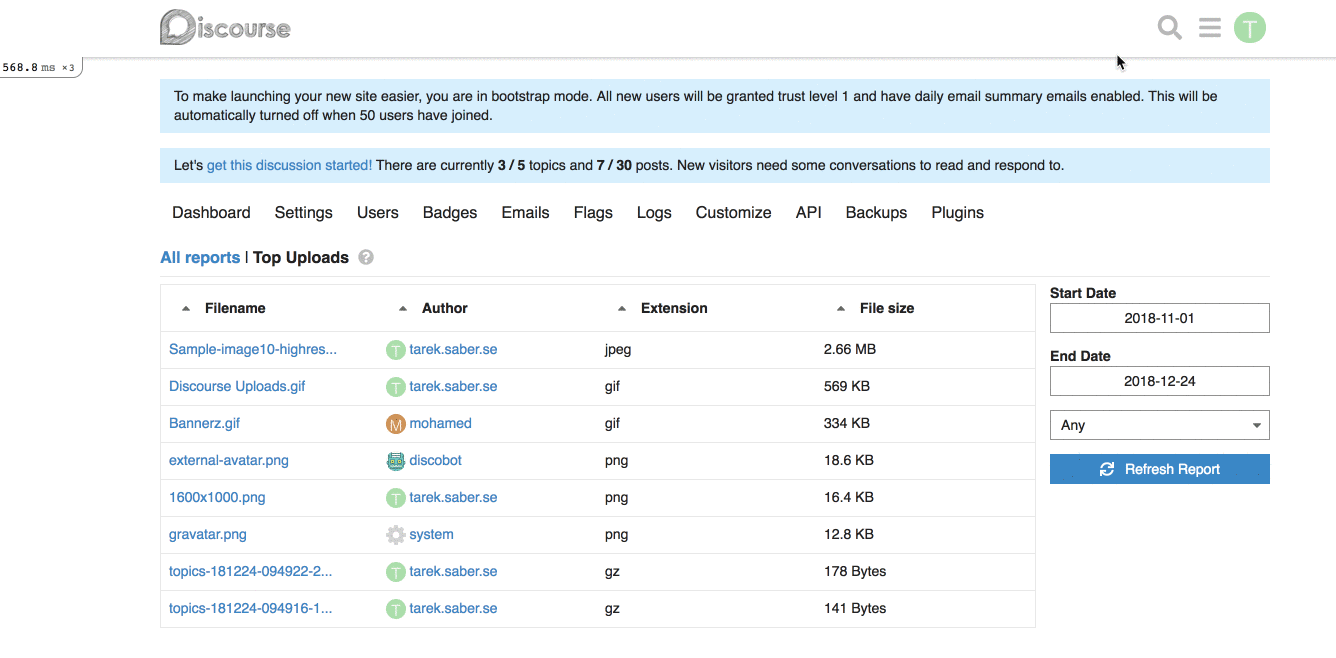This reverts commit d1c4981f65.
Per discussion with @coding-horror it was decided this change is to
far reaching.
Instead we will make smaller strategic changes to tooltips that add
value.
This will allow users installing a Discourse PWA to use their active
theme colors on the generated app. Thanks for @mgiuca for the tip.
Also makes the share_target config explicit to silence Chrome warnings
* improved emoji support
- always optimize images as part of the task
- use the unicode standard ordering/naming for sections
* UX: more height for when there are recently used
Migrates email user options to a new data structure, where `email_always`, `email_direct` and `email_private_messages` are replace by
* `email_messages_level`, with options: `always`, `only_when_away` and `never` (defaults to `always`)
* `email_level`, with options: `always`, `only_when_away` and `never` (defaults to `only_when_away`)
* FEATURE: Exposing a way to add a generic report filter
## Why do we need this change?
Part of the work discussed [here](https://meta.discourse.org/t/gain-understanding-of-file-uploads-usage/104994), and implemented a first spike [here](https://github.com/discourse/discourse/pull/6809), I am trying to expose a single generic filter selector per report.
## How does this work?
We basically expose a simple, single generic filter that is computed and displayed based on backend values passed into the report.
This would be a simple contract between the frontend and the backend.
**Backend changes:** we simply need to return a list of dropdown / select options, and enable the report's newly introduced `custom_filtering` property.
For example, for our [Top Uploads](https://github.com/discourse/discourse/pull/6809/files#diff-3f97cbb8726f3310e0b0c386dbe89e22R1423) report, it can look like this on the backend:
```ruby
report.custom_filtering = true
report.custom_filter_options = [{ id: "any", name: "Any" }, { id: "jpg", name: "JPEG" } ]
```
In our javascript report HTTP call, it will look like:
```js
{
"custom_filtering": true,
"custom_filter_options": [
{
"id": "any",
"name": "Any"
},
{
"id": "jpg",
"name": "JPG"
}
]
}
```
**Frontend changes:** We introduced a generic `filter` param and a `combo-box` which hooks up into the existing framework for fetching a report.
This works alright, with the limitation of being a single custom filter per report. If we wanted to add, for an instance a `filesize filter`, this will not work for us. _I went through with this approach because it is hard to predict and build abstractions for requirements or problems we don't have yet, or might not have._
## How does it look like?

## More on the bigger picture
The major concern here I have is the solution I introduced might serve the `think small` version of the reporting work, but I don't think it serves the `think big`, I will try to shed some light into why.
Within the current design, It is hard to maintain QueryParams for dynamically generated params (based on the idea of introducing more than one custom filter per report).
To allow ourselves to have more than one generic filter, we will need to:
a. Use the Route's model to retrieve the report's payload (we are now dependent on changes of the QueryParams via computed properties)
b. After retrieving the payload, we can use the `setupController` to define our dynamic QueryParams based on the custom filters definitions we received from the backend
c. Load a custom filter specific Ember component based on the definitions we received from the backend
* First take
* Add support for sprites in themes
Automatically register any custom icons added via themes or plugins
* Fix theme sprite caching
* Simplify test
* Update lib/svg_sprite/svg_sprite.rb
Co-Authored-By: pmusaraj <pmusaraj@gmail.com>
* Fix /svg-sprite/search request
* FEATURE: Add `IgnoredUsersSummary` daily job
## Why?
This is part of the [Ability to ignore a user feature](https://meta.discourse.org/t/ability-to-ignore-a-user/110254/8).
We want to:
1. Send an automatic group PM that goes out to moderators
2. When {x} users have Ignored the same user, threshold defined by a site setting, default of 5
3. Only send this message every X days which is defined by another site setting
It is not a setting, and only relevant in specs. The new API is:
```
Jobs.run_later! # jobs will be thrown on the queue
Jobs.run_immediately! # jobs will run right away, avoid the queue
```
Since uploads site settings are now backed by an actual upload, we don't
have to reach over the network just to fetch the favicon. Instead, we
can just read the upload directly from disk.
* FEATURE: Add `Top Ignored Users` report
## Why?
This is part of the [Ability to ignore a user feature](https://meta.discourse.org/t/ability-to-ignore-a-user/110254/8), and also part of [this PR](https://github.com/discourse/discourse/pull/7144).
We want to send a System Message daily when a specific count threshold for an ignored is reached. To make this system message informative, we want to link to a report for the Top Ignored Users too.
We can only be sure that an email is sent when we get a mailer in
`ActionMailer::Deliveries`. A couple of tests were actually incorrect
because it didn't flow through our email sender where there are more
conditions in determining whether an email is sent or not.
* FEATURE: Account for `ignored_users` when merging two users
## Why?
This is part of the [Ability to ignore a user feature](https://meta.discourse.org/t/ability-to-ignore-a-user/110254/8).
When we merge two users, we need to account for merging their list of `ignored_users` too.
- Notices are visible only by poster and trust level 2+ users.
- Notices are not generated for non-human or staged users.
- Notices are deleted when post is deleted.
It seems that due to jobs being asynchronous and wrapping code in a
DistributedMutex that by the time we run the
`UserAvatar#update_gravatar!` job that the user/user email might be
destroyed.
This patch checks before a call to `user.email_hash` to make sure
the user and primary email exist to prevent the exception. If not
present, the job exits as there's nothing to do because we are
probably running after the user was destroyed for some reason.